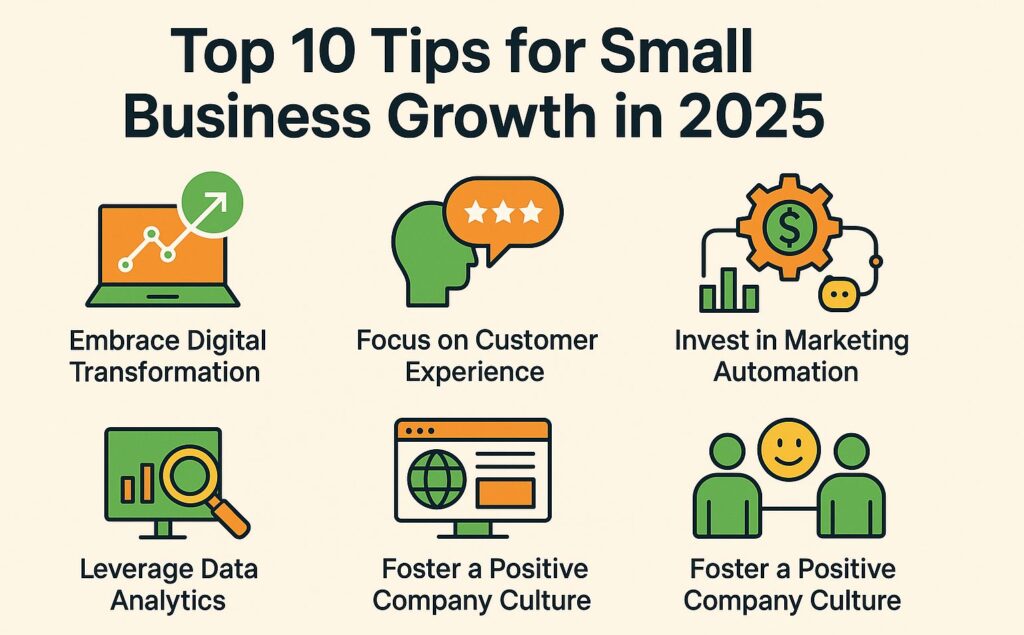
Top 10 Tips for Small Business Growth in 2025
Ready to elevate your small business? As 2025 nears, there are many chances for development. Knowing important trends and strategies can give you a competitive advantage. These top 10 tips for small business growth will help you focus on digital change and improve customer experience. Learn how to use data effectively, create a reliable online presence, and encourage a supportive culture to achieve success. Let's dive into the essentials that will set you apart this year!
Importance of Business Growth
Business growth is important because it supports long-term success, encourages innovation, and increases customer loyalty.
For example, Starbucks has grown its menu by adding seasonal drinks and food items, which encourage customers to return.
The company uses loyalty programs to increase customer involvement, giving frequent buyers special deals and access to exclusive products.
By analyzing customer data, they tailor their marketing strategies to target specific demographics, thus maximizing customer engagement and their reach.
Small businesses can gain by identifying exact customer needs, broadening their products, and using customer feedback to improve their services continuously.
Overview of 2025 Business Trends
In 2025, trends like changes in technology, data analysis, and social media use are expected to change how businesses operate.
Companies will start using new data analysis tools like Google Analytics 4 and Tableau to understand customer behavior, helping them create focused digital marketing plans.
For instance, e-commerce is projected to see a 20% growth, emphasizing the need for effective digital marketing. Businesses will use social media sites like TikTok and Instagram to honestly engage with their audience, benefiting from the shift to video content.
By teaching employees how to use these technologies, companies can remain competitive in a fast-changing market. Curious about how businesses can sustain these changes and growth? Our analysis on the cost of time tracking software in 2025 could offer some valuable insights.
Tip 1: Embrace Digital Transformation
Adopting digital changes can open new opportunities for improving operations and connecting with customers, which is important for business growth and entrepreneurship.

Utilizing Cloud Technologies
Using cloud tools such as Google Workspace ($6/user/month) can make processes more efficient and improve teamwork.
These tools allow teams to work seamlessly from anywhere.
Slack helps teams talk instantly, cutting down on emails and speeding up decisions.
Asana serves as a project management platform where tasks can be assigned, deadlines set, and progress tracked, enhancing accountability among team members.
Using cloud storage solutions such as Dropbox enables easy file sharing and secure backup.
By integrating these services, organizations can experience significant time savings, often reducing project completion times by up to 30%, improving operational efficiency.
Adopting E-commerce Solutions
Using e-commerce platforms such as Shopify ($29/month) can greatly increase sales and attract more customers, aiding in business expansion.
By streamlining setup, Shopify allows you to start selling within hours. Use its built-in payment gateways, tools for managing inventory, and changeable templates to make a good-looking store.
For those wanting more flexibility, WooCommerce is a WordPress plugin that allows for a lot of customization and is free to get started. Businesses transitioning to these platforms have reported sales increases of up to 50% in just a few months.
Improve product pages by using clear photos and interesting descriptions to make them more attractive and boost sales.
Tip 2: Focus on Customer Experience
Paying attention to customer experience with customized interactions can result in higher conversion rates, more loyal customers, and higher sales.
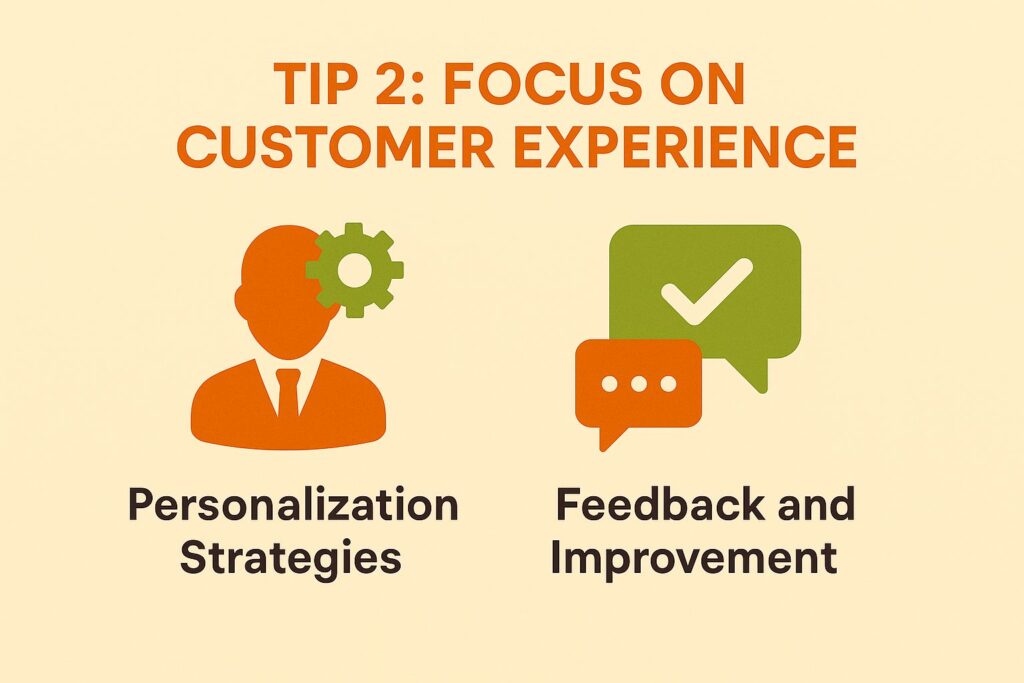
Personalization Strategies
Using HubSpot CRM, which is free for essential functions, can greatly improve how customers interact with your business.
By segmenting your email lists based on customer behavior and preferences, you can create targeted campaigns. If a customer often looks at a certain section on your website, you should send them emails with items from that section.
Use HubSpot's A/B testing tool to find out which subject lines connect better with your audience. Sending custom follow-up emails, such as thank-you notes after buying something, can increase customer loyalty and raise conversion rates by up to 202%. This method helps your content succeed.
Feedback and Improvement Loops
Using surveys and reviews to create regular feedback loops and improvement cycles can directly increase customer satisfaction.
Use SurveyMonkey (free-$32/month) or Google Forms (free) to make surveys that measure customer thoughts on product features and service experiences.
To understand more clearly, use Net Promoter Score (NPS) surveys to identify who likes your brand and who doesn't.
Once you collect this data, analyze customer responses using software like Tableau or Excel to identify trends and areas for improvement.
Use this feedback to improve products or change service procedures, creating more customized options that connect with your audience.
Tip 3: Invest in Marketing Automation
Using marketing software can greatly improve how effectively small businesses operate and increase their return on investment, enhancing their marketing strategies.
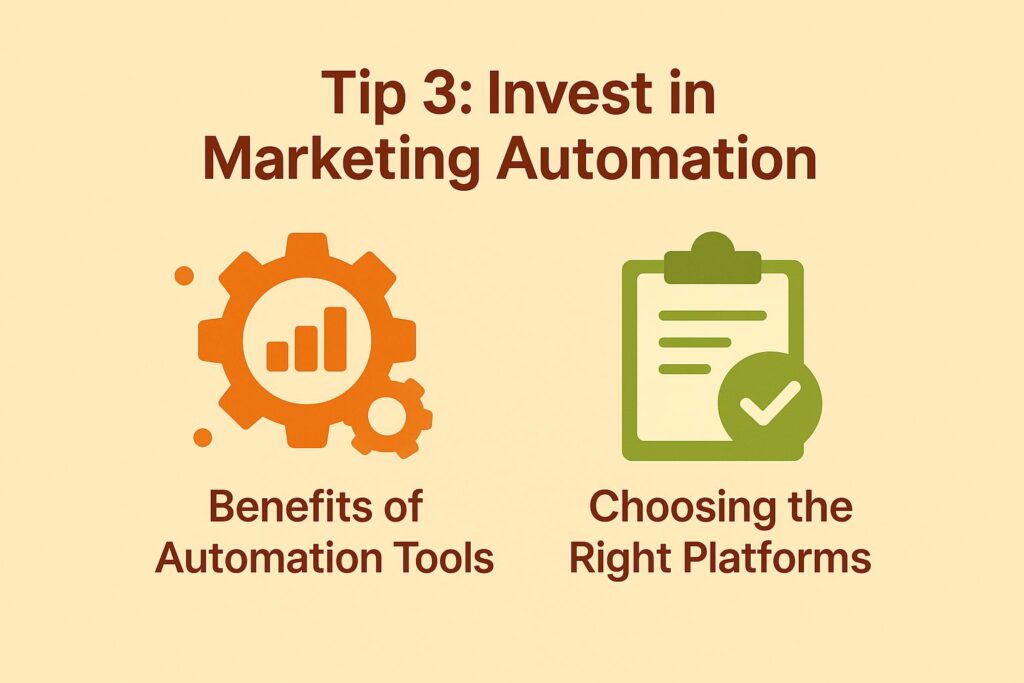
Benefits of Automation Tools
Automation tools like Mailchimp (free-$350/month) can save time by streamlining email marketing campaigns.
By automating repetitive tasks, businesses can focus on strategy and creativity. For example, a small store increased sales by 30% after setting up automatic emails for abandoned shopping carts.
Tools like HubSpot and ActiveCampaign send emails automatically and give data to help you make them better. Meanwhile, Pardot provides strong A/B testing features, enabling companies to improve their messaging and reach greater interaction levels.
In the end, using marketing software makes work faster and helps make decisions based on data, leading to big improvements.
Choosing the Right Platforms
Selecting the right marketing platforms involves evaluating features, costs, and scalability, starting with tools like HubSpot and Marketo.
Other noteworthy choices include Pardot, recognized for its strong B2B functions, and ActiveCampaign, which is great for automating tasks.
HubSpot offers an all-in-one solution that integrates CRM, email, and content management from $45/month, ideal for startups. Marketo, pricing starts at around $1,000/month, targets large enterprises with advanced analytics and lead scoring.
Pardot, also a Salesforce product, is excellent for high-value conversions, while ActiveCampaign's plans from $9/month cater to small businesses focused on email marketing automation.
Assess your unique business needs to select the ideal platform.
Tip 4: Leverage Data Analytics
Using data analysis helps understand customer behavior and make informed business decisions.
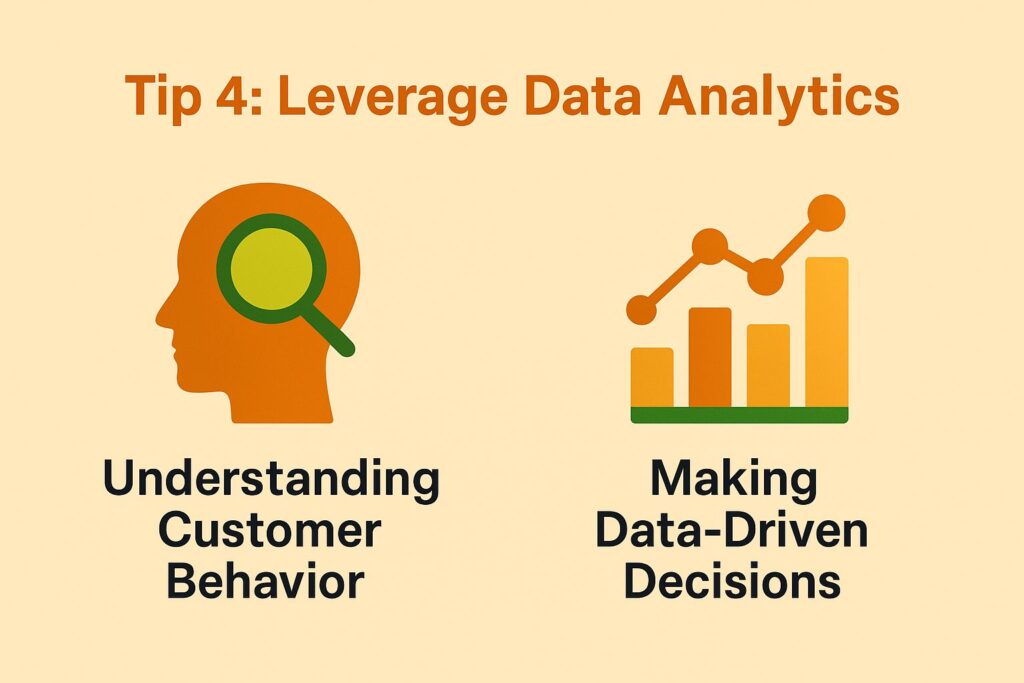
Understanding Customer Behavior
Tools like Google Analytics (free) show information about how customers act, which helps to adjust marketing plans successfully.
To set up Google Analytics, first create an account and add your website as a property. Put the tracking code on all pages of your website by following these steps, ensuring proper analytics and user experience tracking.
Once data starts flowing in, focus on the Audience Overview to understand visitor demographics and behavior. For instance, if you notice a high bounce rate on a specific landing page, consider revising the content or design to improve user experience.
Use the Acquisition reports to evaluate the performance of your marketing channels, adjusting your strategy based on which sources drive the most engaged users. Check these details often to improve your campaigns!
Making Data-Driven Decisions
Adopting a data-driven approach enables businesses to make informed decisions that align with customer preferences.
To put this method into practice, start by choosing a visualization tool like Tableau, which provides solid data visuals for around $70 per month.
Gather data from sources such as Google Analytics, CRM systems, and customer feedback surveys.
Next, create dashboards focusing on key performance indicators (KPIs) relevant to your objectives, such as sales trends or customer engagement metrics.
Regularly check these dashboards to find trends and adjust your plans with current information. This repeated process guarantees that decisions are shaped by real data rather than guesses.
Tip 5: Build a Strong Online Presence and Brand Awareness
Having a strong online presence helps increase brand recognition and effectively connect with your target audience. To enhance this connection, it's important to know how to compete with established brands. Discover our hidden gem: How to Compete with Big Brands (Even on a Small Business Budget), which offers valuable insights for leveling the playing field.
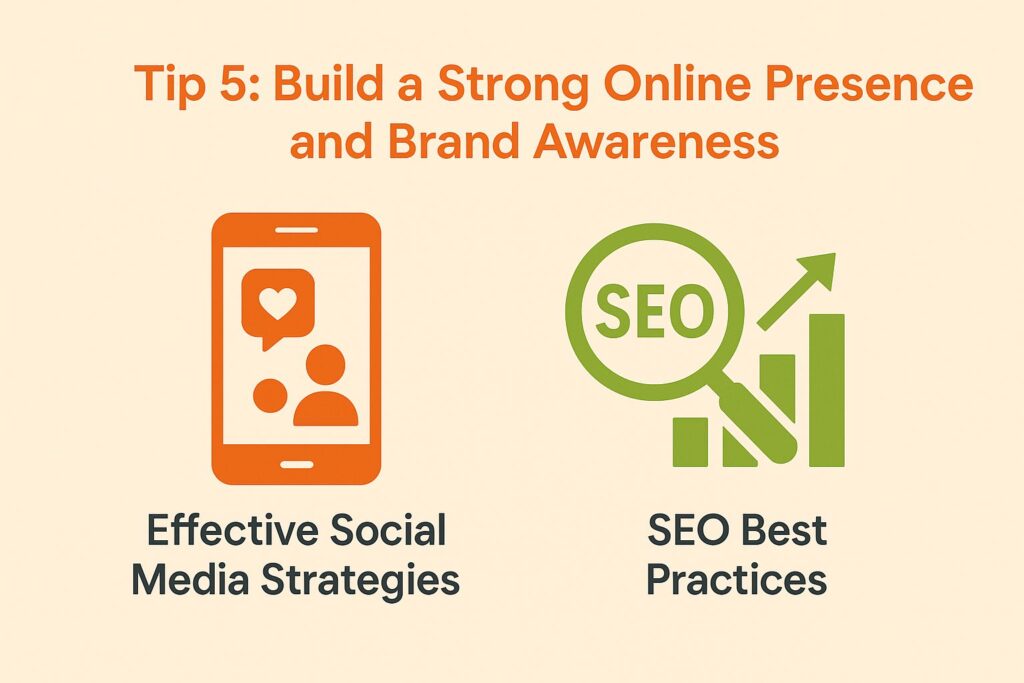
Effective Social Media Strategies
Using well-thought-out social media plans can greatly increase interaction, improve brand loyalty, and strengthen customer loyalty to the brand.
To maximize your social media impact, focus on these strategies:
- Post consistently, ideally 3-5 times a week, to keep your audience engaged.
- Use a mix of content types-regular updates, behind-the-scenes glimpses, user-generated content, and polls-to maintain interest.
- Track performance using tools like Hootsuite Analytics or Sprout Social.
Brands like Nike saw over a 100% increase in engagement by sharing authentic stories and encouraging community involvement. Regularly look at your data and change your plan so your content connects with your audience.
SEO Best Practices
Using effective SEO methods can improve your website's presence and increase visits from search engines.
Start with keyword optimization; use tools like SEMrush ($119/month) to find relevant keywords and analyze their performance. Use these words carefully in your content, especially in titles and opening sections, for better SEO optimization.
Next, don't overlook meta tags-specifically, title tags and meta descriptions, which influence click-through rates and overall SEO performance.
Develop a solid backlink strategy by using platforms such as Ahrefs to identify high-quality sites for guest posting opportunities, impacting your overall content marketing strategy.
By implementing these steps consistently, you can significantly improve your search engine rankings and audience engagement, which contributes to better business planning and growth metrics.
Tip 6: Build a Positive Company Culture
Building a positive company culture can improve employee involvement and increase productivity throughout the organization, contributing to better workforce development.
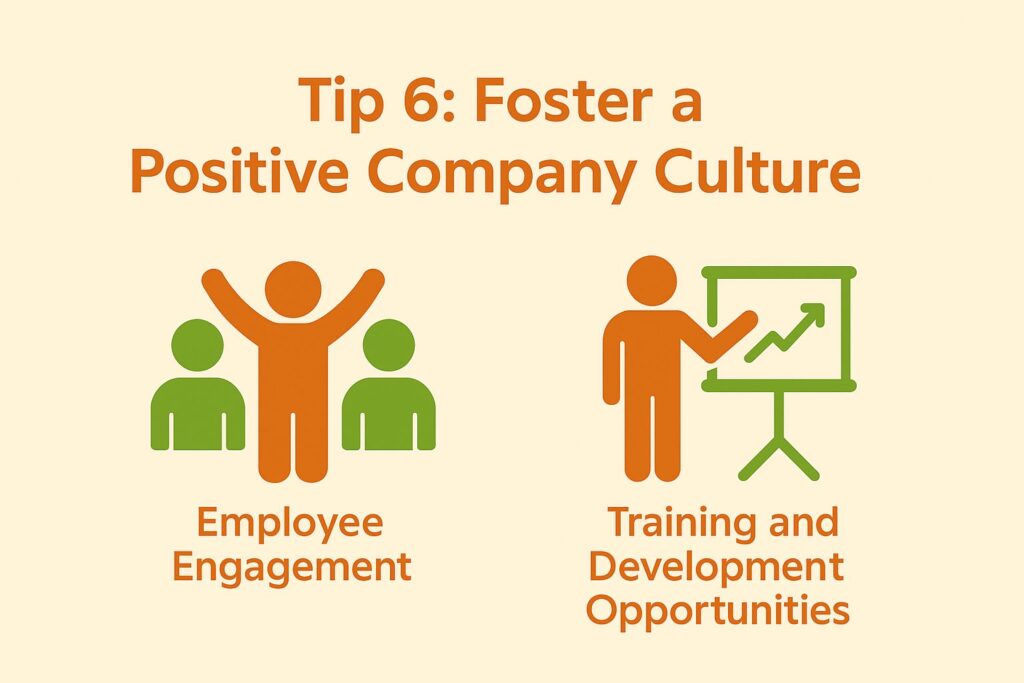
Employee Engagement Techniques for Improved Employee Training
Implementing employee engagement techniques like regular feedback sessions can significantly improve retention rates and overall employee training effectiveness.
Programs that acknowledge employee achievements are also effective; research indicates that companies with good recognition methods have 31% less employee turnover, which is important for business stability.
For instance, consider implementing a monthly ‘Employee of the Month' award that includes a tangible reward, like a gift card or an additional day off, as part of your employee engagement strategy.
Team-building activities, like quarterly off-site retreats or monthly team lunches, help build strong relationships among team members.
Metrics like employee satisfaction surveys and turnover rates should be monitored to assess the impact of these initiatives on productivity and morale, essential for strategic partnerships and stakeholder engagement.
Training and Development Opportunities
Offering training and development lets employees improve their skills and builds loyalty to the company.
Employers can consider using a combination of online courses, workshops, and mentorship programs to improve skills, which is important for ongoing workforce development.
For example, platforms like Coursera offer courses starting at $39/month, focusing on topics ranging from project management to coding, aiding in technology integration and skill development.
Research shows that companies investing in continuous learning see a 30% increase in employee satisfaction and performance metrics.
Holding workshops within the company can customize training to fit your team's specific needs, which often results in better involvement and memory retention.
Tip 7: Network and Collaborate
Working together and building connections can create important partnerships, helping businesses grow by sharing resources and information. This is especially important for small businesses looking to compete with larger brands. Learning how to compete with big brands, even on a small business budget, can provide actionable strategies to leverage these partnerships effectively.
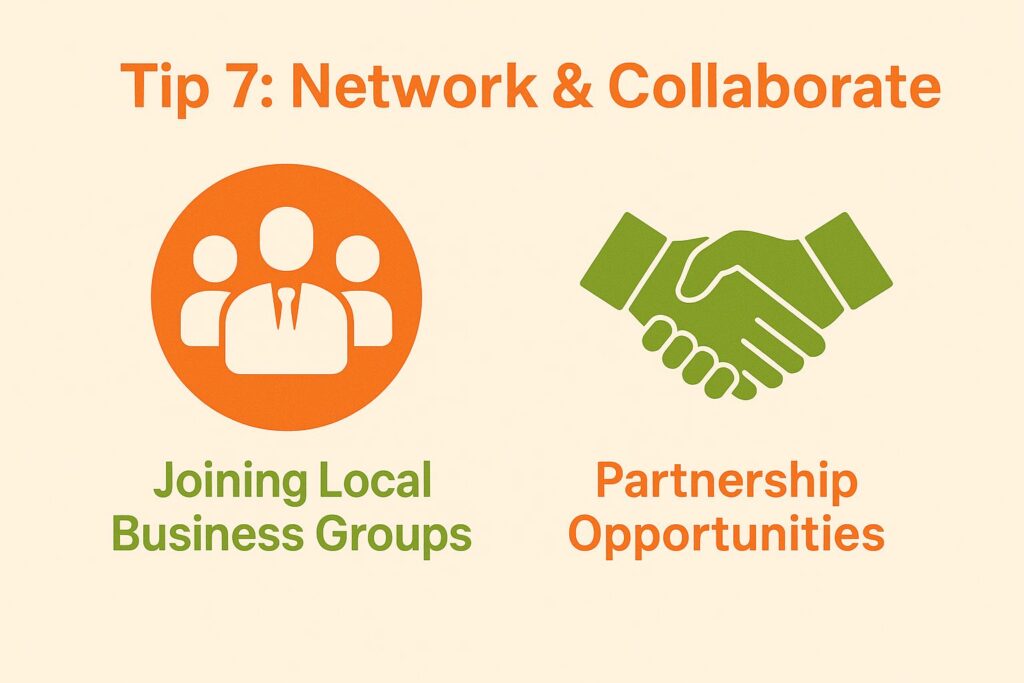
Joining Local Business Groups for Efficient Business Networking Events
Joining local business groups can offer good chances to meet new people and get involved in community activities, enhancing your local marketing efforts.
To effectively engage, consider joining local chambers of commerce such as the San Diego Regional Chamber of Commerce or the Atlanta Chamber of Commerce.
Attend their networking events, workshops, or webinars to connect with other business owners. For instance, the New York City Small Business Services hosts monthly meetups that have led to partnerships, resulting in business expansion for many participants, which is beneficial for lead generation and customer retention.
Working together on community events with these groups increases your visibility and builds positive relationships, improving your business's reputation in the local area, and enhancing your brand positioning.
Partnership Opportunities
Partnering with companies that provide various services can help access new markets and attract more customers, which is important for market placement and forming strategic partnerships.
Start by identifying potential partners that share your target audience but offer different products or services. For instance, a gym might partner with a local health food store for cross-promotion.
Next, contact them with clear benefits; suggest organizing joint events or creating product bundles. Successful examples include joint promotions like workshops that teach customers from both businesses, benefiting everyone involved, which is a good affiliate marketing strategy.
Using tools such as LinkedIn for connecting with others and email marketing platforms for reaching out can simplify building partnerships, aiding in business networking events and overall business growth.
Author: Hudson Piccini
Hudson Cynar, a Harvard University alumna and the owner of three prosperous enterprises, is a distinguished business consultant, author, and writer. Her expertise spans multiple business sectors, with a particular emphasis on storage containers, commercial copiers, payroll services, and medical billing software. Dedicatedly investing thousands of hours into product and service research, Hudson crafts insightful reviews to guide entrepreneurs in making informed decisions for their businesses.